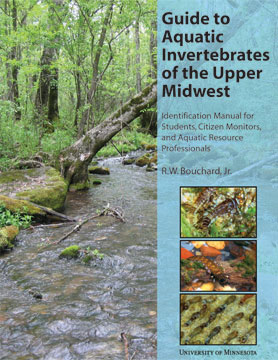Identification Manual for Students, Citizen Monitors, and Aquatic Resource Professionals
Edited By:
L.C. Ferrington, Jr.
M.L. Karius
The Guide to the Aquatic Invertebrates of the Upper Midwest was developed to aid students, teachers, volunteers, and other individuals that wish to identify aquatic macroinvertebrates to the family level. Aquatic invertebrates are important components of aquatic systems and are effective tools for measuring the condition of streams, wetlands, and lakes. For example, some species are tolerant of pollution, so when a stream has a large number of these tolerant organisms, it is an indication that there are potential water quality problems. The use of biological components to monitor water quality by volunteers can be used to augment professional programs and subsequently improve early or long term monitoring programs. In addition, volunteer programs are effective educational tools as the give those involved a better understanding of aquatic systems by providing a tangible link between aquatic organisms and the impacts humans have on these systems.
The goal of this guide is to improve the accuracy of identifications and give volunteers a better understanding of the organisms inhabiting streams, wetlands, and lakes. The keys in this guide are specifically designed to be easy to use by individuals with limited experience with dichotomous keys. Included within the guide are keys for common aquatic and semi-aquatic invertebrates found in Minnesota and the Upper Midwest region (including insects, snails, worms, crustaceans, etc.). In particular, the guide focuses on invertebrates that are usually encountered in commonly used sampling protocols. For each group there is also a description that includes information such as their feeding mode, habitat they are commonly found, their pollution tolerance, identifying characteristics, and information on their biology.
Please email Will Bouchard ([email protected]) to purchase this guide.
